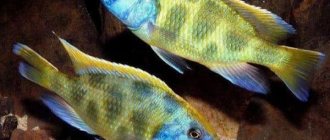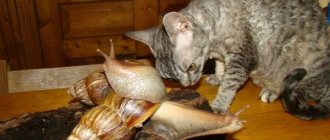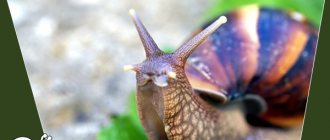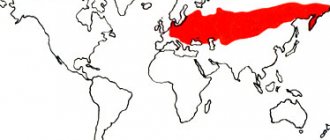About Malawian cichlids home page
Malvian cichlids
The genus Cynotilapia today has only three species:
- Cynotilapia afra;
- pulpican;
- axelrodi.
Cynotilapias are rare in aquariums. Small in size (up to 10 cm), but very aggressive fish. They actively protect their spawning grounds from any aliens. It is better to keep it in a species aquarium. They feed on zooplankton. They live in flocks near coastal cliffs. The body shape is typical of cichlids and especially resembles Pseudotropheus. A distinctive feature is the elongated hard rays on the fins - a tool of passive protection. Fish obviously have a very ancient genus, since they have retained the amazing ability to change sex in cases where there are no individuals of the opposite sex in the group. True, changes in them occur only externally and only in females. The dominant female becomes masculine—painted in the colors of the spawning male. The purpose of this mechanism in nature is not clear. It's probably just a rudiment.
Habitat in nature
Cynotilapia afra (formerly Paratilapia afra) was described by Gunther in 1894. The genus name roughly translates to dog-toothed cichlid (hence the name blenny cichlid), and describes the sharp, conical-shaped teeth unique to this genus of Malawian cichlids. Endemic to Lake Malawi.
The species is widespread along the north-west coast as far as Ngara. Along the east coast it can be found between Makanjila Point and Chuanga, Lumbaulo and Ikombe, and around the islands of Chizumulu and Likoma.
This cichlid lives in rocky areas around the lake shoreline. They are found at depths of up to 40 m, but are most common at depths of 5 - 20 m. In the wild, females are solitary or live in small groups in open waters, where they feed mainly on plankton.
Males are territorial, defending their territory in the rocks, and feed mainly on tough, fibrous algae that attach themselves to the rocks.
Males tend to feed from cliffs near their home. Females gather in the middle of the water and feed on plankton.
Evolution of the cichlids of Lake Barombi Mbo
Lake Barombi Mbo (Photo by Jaibidodan)
Rapid evolutionary changes in the Great African Lakes have affected not only cichlids, but also other representatives of flora and fauna, such as snails. The species diversity of life present in the lakes most likely originated from one or two colonizing species, which is confirmed by the results of studies conducted on the small Cameroon volcanic lake - Barombi Mbo. A small river flowing into it saturated the nearby waters of this lake with oxygen, while on the opposite shore it flowed out of the lake, and there the opposite effect occurred: nutrients suspended in the water settled to the bottom due to the lack of flow. These two facts influenced the colonization of the lake in the following way. The fish that got into it initially divided into two groups, which settled at different ends of the lake. At the confluence of the river, turbulent water brought food items to the surface, and in order to successfully feed near the surface, the cichlids of this area had to modify themselves. At the same time, the cichlids in the southern part of the lake changed and adapted to searching for food at great depths. Under such conditions, both populations flourished, expanded their habitats and inevitably met over time, which led to noticeable changes in these fish: in order to avoid competition, the local southern population of the competition moved to shallower water. When the southern cichlids, following the same path, moved north, the opposite effect occurred, and the northern relatives living there began to explore deeper water. Currently, this population (Konia dikume) has acquired a remarkable ability to dive to low-oxygen depths in search of fly larvae. The latter became possible due to changes in the oxygen-containing hemoglobin molecules found in red blood cells. Meanwhile, the cichlids that migrated to the shallow waters of the lake once again divided into two populations, one of which feeds during the day, and the other at night.
The black-spotted pungu (Pungu maclareni) is an endemic cichlid of Lake Barombi Mbo (Photo by Melvin Tullek)
There were other evolutionary processes, as a result of which the lake. Barombi is now inhabited by four endemic genera of cichlids, which include two species of Konia, three species of Stomatepia and one each of Myaka and Pungu. In addition, the lake is home to four endemic species of the genus Sarotherodon. The common ancestor of all these cichlids is considered to be a single species of the genus Saroterodon, but the fact of the origin of these fish from one ancestor is questioned by some modern researchers.
Description
Males can grow up to 10 cm, females are usually somewhat smaller and less brightly colored. Cynotilapia afra has an elongated body with vertical blue and black stripes.
However, there are many different color patterns depending on the region the fish comes from.
For example, the Jalo Reef population does not have yellow in its body, but does have a yellow dorsal fin. Other populations do not have yellow in their color at all, but in Kobuye it is the main color.
Body structure and eating habits
The enormous success of cichlids in the African Great Lakes is largely due to their ability to utilize a variety of food sources, from microscopic algae to fish. It is believed that the first early colonizers of lakes were riverine species that had a fairly universal specialization in food. From these fish arose various modern species, with a specialized body structure, equipped with such adaptations as: retractable jaws, teeth adapted to catch various types of organisms, as well as means of camouflage - in the form of coloring, color patterns, modified bodies, etc. Almost all of these adaptations affect the efficiency with which fish feed, and each of them has to do with anatomy. Cichlids have two sets of jaws, one of which is located in the mouth and is used for sucking, cleaning or biting off a piece of food, and the other is located in the throat and is used for further crushing, grinding, tearing or piercing it. Among freshwater fish, only cichlids possess this second modified set of jaws, which are essentially transformed gill arches (the series of bones on which the gills are located). Fish can manipulate these two sets of jaws extremely easily, which can also quickly adapt and change shape. Teeth can also change during one life, transforming from pointed-piercing to flat-crushing and becoming similar to molars. Cichlids that prefer one type of food to another can be very different in appearance.
Lake Tanganyika (Kagongo) (Photo by Philippe Collete)
Cichlids' two sets of jaws are finely tuned to suit their feeding habits and this allows each species to occupy its own very specific ecological niche. The latter circumstance favors the joint coexistence of hundreds of species and allows them to avoid direct competition for available food sources. Otherwise, the use of the same food resources would lead to the complete disappearance of most of them. The most unusual example of such food specialization is the scale-eating cichlids. Their hunting method is quite simple: they approach their victims - other cichlids - from behind and knock off the scales from their sides. This type of cichlid is found in lakes Malawi, Victoria, and Tanganyika, and each species has its own adaptation to this method of obtaining food. In the lake Malawi scaly-eating cichlids include Genyochromis mento, as well as representatives of the genus Corematodus, in Lake. Victoria - Haplochromis welcommei, in Lake Tanganyika - two species of Perissodus, one of which, Perissodus microlepis (P. Microlepis), occurs in two different forms of head and jaws, curved either to the right or to the left. These fish do not just feed on one scale, but specialize in tearing off scales from one specific side: left-handed fish attack their prey from the right, and right-handed fish from the left. This surprising asymmetry in the morphology of the same species most likely evolved only because the curvature of the head facilitates more efficient capture of knocked-off scales. The scales are difficult to swallow individually, so the fish stacks them in the throat like sheets of paper with the help of a second set of jaws, and only then swallows them with one foot.
Fishermen in the southern part of the lake. Malawi (Photo by Graham Hobbs)
Their victims, as a rule, survive, but later they begin to fear attacks - from both sides, which implies approximately equal numbers of right- and left-snouted perisodus in the lake. When the population of right-handers, for example, begins to exceed the population of left-handers, their victims become more afraid of attacks from the left side, and left-handers have an advantage in increasing their population, which maintains an approximately equal balance of power.
Content complexity
This is an excellent fish for both advanced and experienced aquarists. Can be easy to keep, depending on the aquarist's willingness to make frequent water changes and provide appropriate maintenance parameters.
This is a moderately aggressive cichlid, but is not suitable for a community aquarium and cannot be kept with fish other than cichlids. When properly maintained, it easily adapts to feed, reproduces easily, and young animals are easy to raise.
Fish diseases
The main problem is side diseases caused by poor nutrition. Failure to maintain a balance between meat and plant products leads to upset of the digestive system and, as a result, fish becomes susceptible to various diseases. Similar problems arise when water quality deteriorates and/or does not meet the necessary parameters. Read more about symptoms and treatment methods in the section “Diseases of aquarium fish”.
Peculiarities
- Polygamous species, one male and several females, keeping two or more males is unacceptable
- Mandatory combination of plant and meat feeds
Keeping in an aquarium
The majority of the aquarium should contain piles of rocks arranged to form caves with small areas of open water in between. It is best to use a sandy substrate.
Cynotilapia afra has a tendency to uproot plants through constant digging. Water parameters: temperature 25-29°C, pH: 7.5-8.5, hardness 10-25°H.
Malawian cichlids will degrade in poor water conditions. Change water 10% to 20% per week depending on biological load.
Feeding
Herbivorous.
In the tank they will eat frozen and live foods, high quality flakes, pellets, spirulina and other omnivorous cichlid foods. They will eat to the point that they cannot digest the food, so be very careful not to overfeed.
It is always better to feed them small meals several times a day instead of one large feeding.
Fish will accept most of the food offered, but plant matter in the form of spirulina, spinach, etc. should make up the majority of the diet.
Nutrition
The diet consists of meat and plant products: live or frozen bloodworms, mosquito larvae, pieces of earthworms and/or shrimp, algae flakes. The best option is to use specialized food for cichlids from a specific lake, in this case Malawi. They contain the necessary elements and vitamins for full growth, and bloodworms and similar products can be used as a supplement.
Our product Aqvium natural dry food for small and medium fish from clean lakes of Siberia and Northern Crimea in environmentally friendly biodegradable packaging.
Find out more











